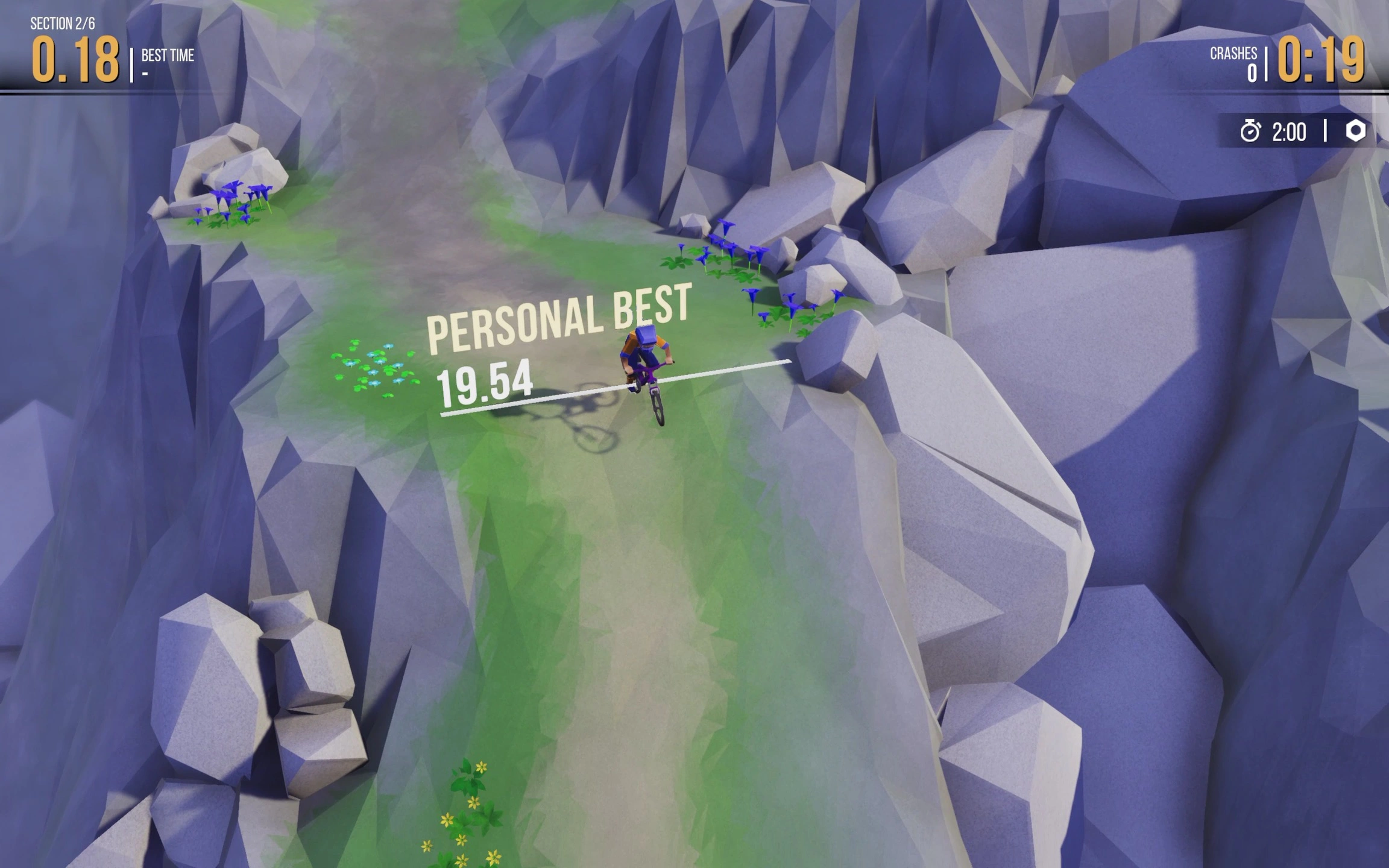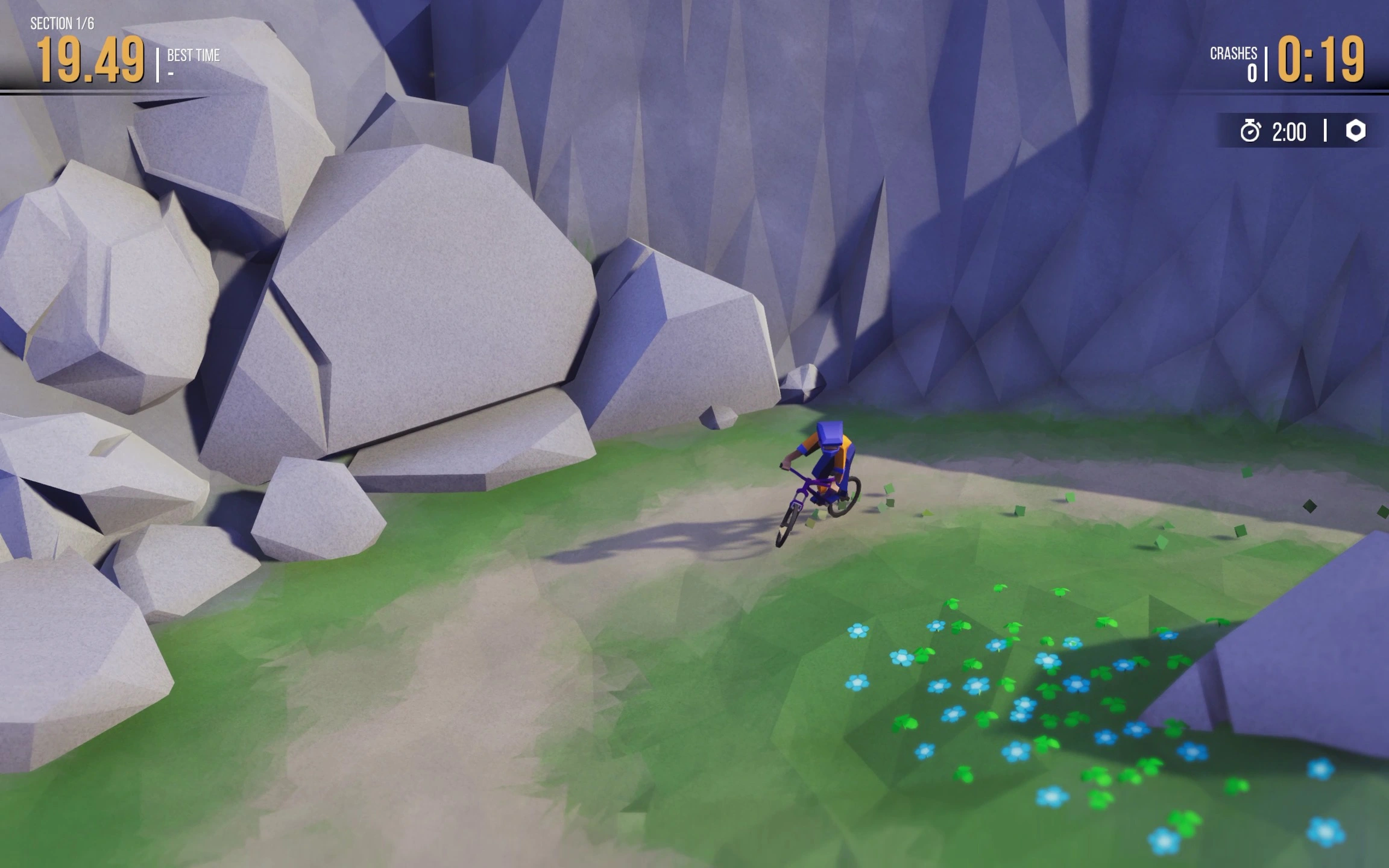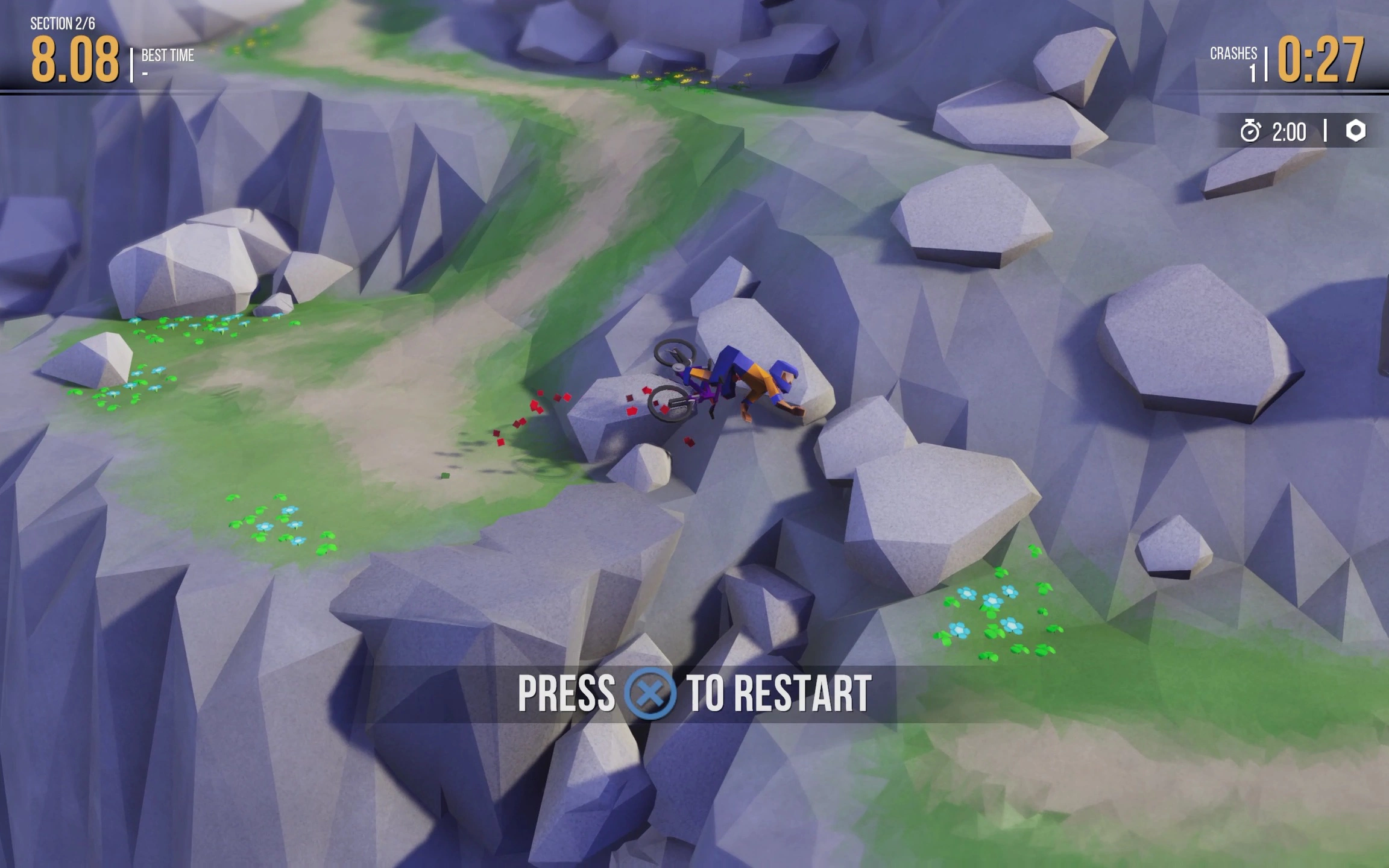by Stuart Urback
Enter Lonely Mountains
Lonely Mountains is a game about downhill mountain biking. Developed by Megagon Industries and released in 2019, available on Switch, Xbox, PlayStation and PC. You are a rider on a bike, at the top of a mountain, and your goal is to get down it quickly and with as few crashes as possible. You have to learn how to brake, turn, drift, jump, and avoid obstacles to get to the bottom. There are checkpoints on the way down which you will restart at anytime you crash. Often you are trying to complete an objective like minimizing crashes or getting down the mountain as fast as possible.
The focus of Lonely Mountain is on the player’s ability to navigate the different challenges on your way down the mountain. There isn’t a lot of content that you might find in other games like enemies, puzzles, or a randomized path. The rewards for a successful run are minimal, besides unlocking new bikes and new routes. Once you’ve seen the challenges on one mountain, you have a good sense of the types of challenges you’ll see throughout the rest of the game. And yet, Lonely Mountain shines as an experience because of the quality of the challenge and the excess of game-feel.
Going Downhill

There are some clever, subtle designs that highlight how Downhill helps players achieve game-feel, without pushing them over the edge to get there. When you first encounter a new course on a mountain (i.e. “explorer” mode), it’s pretty much all guardrails. There are no objectives or achievements to unlock. There are roughly 7 gates (save checkpoints) per course that you have to cross to unlock the next set of goals for the course, but no time limits to encounter. This sets up a sort of exploratory mode for the player, where you can make your way down the mountain, trying new things out, but with the main goal of getting a feel for the course. It’s also not so exploratory that someone like me (who likes guardrails) gets lost.
Once you’ve completed that, the next set of “beginner” goals are typically speed and crash based. You have to make it to the bottom of the mountain within a certain amount of time, and (hopefully) having crashed fewer than 13-20 times (depending on the course). This is an increased challenge, but one that feels doable. One of the things I noticed is how early in the course I would try to play perfectly, aiming to collect both rewards (for both time and speed), but usually about halfway through I would fail one of them. Rather than being disappointed, I would feel freed to throw all my effort into the other goal. For example, if I ran over my crash limit, I would throw myself down the course with wild abandon, not caring about how many times I fell to my doom. The “expert” challenges are an extension of “beginner” but with harder goals and a twist (like a combination of crash maximum and time limit). The final “free rider” challenge is always to go down the mountain in one go, without any crashes. And to be frank, I’ve never once tried these. Subsequent paths and new mountains have opened up quickly enough that I’m able to play at the pace I want to, without having to push so hard out of necessity. I’m able to tune my challenge to the extent I want, without feeling like I’m cheating myself of an experience.
There are other small touches that make the game seem to sing as well. The sounds of birds chirping and water running in the background is soothing. The giant red cubes that come spilling out of the rider when they crash are cringe inducing but funny, in that kind of knee-jerk reaction you make seeing a funny YouTube video. The haptic feedback on the controller creates a tactile experience and provides useful information. These small but positive experiences add up to a game that feels like it cares about your big and small emotions, but without forcing you into a mood.
This Flow Thing

The sparsity of Lonely Mountains does a good job of reinforcing the fact that I was alone, playing a video game. And in the year 2020, where social/political unrest run rampant and a pandemic is completely out of control, being alone playing a video game (a game that reminded me I was alone), feels indulgent and almost pointless.
This reminded me of Tevis Thompson’s the worst games of 2018. In his review of Dead Cells, he talks about the relationship between that game’s content and being challenged in the world.
We still care too much about game-feel. See Destiny. See also Celeste. There’s something icky about the way game critics fetishize it. That luscious feedback, that perfect extension of your will, that zone you wish to stay in forever. Gross.
While Lonely Mountains is a different from a game like Dead Cell’s in the sparse lack of content, the focus on game-feel is similar. Was I also fetishizing game-feel as an escape?
For those that might not know, game-feel is a somewhat insider term that references the relationship between the UI of a video game and your ability as a player to use that UI to do what you accomplish, as popularized in a book Game Feel by Steve Swink. Games with strong game-feel will tend to feel like you can play the game as though it was an extension of your mind. The translation from thought to action is near instantaneous. What Film Critic Hulk called when “games match our expectations and move at the speed of our intentions.” For me, Downhill’s feedback, sound, and visuals hit all the right notes of achieving perfect game-feel, but it also seemed to connect with something deeper. But what differentiates it from Dead Cells or Destiny or other games that Tevis argues fetishize game-feel?
The Feel Of It
I played baseball for most of my childhood. Occasionally I touched something approaching decent (until high school), and I enjoyed it quite a bit because doing the basic motions of baseball are fun. Tracking a ball into your glove until you hear it pop and feel your hands close around the glove. When I pitched, I even enjoyed the “look back”; going into my windup on the mound, and turning my head to look back at the runner on second base. But nothing could quite compare to the feel of throwing a baseball.
The literal motion of my arm through the air. Feeling my muscles tense and release as I executed a series of motions to get the ball where I wanted it to go as fast as possible. Feeling the grip of my fingers across the seams of the ball. This all might seem silly, but to me, it’s a physical equivalent of the feel of a response UI on a computer screen, or sounds and haptic feedback when executing a move. That sum of sensory feedback feels good. We don’t really call these things game-feel when they involve sports, but it’s the same general principle.
Doing Stuff is Hard

One was the act of doing the thing, and two was the act of learning to do the thing well. Doing something a lot means a lot of failure. As a pitcher in high school, I would throw the ball to a place I didn’t exactly intend. It’s a reminder that getting our bodies to do a specific thing we want is not automatic. In fact, it is frequently difficult. I cannot tell you how many times after practice I would go home with a sore arm, or end a game disappointed with the results. But I will also never forget the time I worked with my pitching coach to get the correct shoulder motion to increase the velocity of the ball when I threw it.
I think Lonely Mountains is fun for the same reason I think sports is fun, for the same reason I think other pursuits like knitting, or piano are fun. Learning control over different physical motions is a skill, and it’s something that is easy to forget has to be practiced. But it’s that practice we can develop new skills through understanding the way our bodies work and the way they relate to the world. It’s what Ian Bogost calls an inversion of the ground, which is what makes games fun. It’s the feel, the relationship between our actions and our senses that guides us to helping understand what we are capable of. I could not exactly tell you the physical motions I’m going through when I throw a baseball or when I’m careening down a mountain in Downhill, but I can easily feel my way through it.
I've never mountain biked, and I don't intend to. But the game connected with me, and specifically with the part of me that used to play baseball. The motions of going through the same section of a mountain course over and over again reminded me of times with my pitching coach, learning how to throw the ball faster. It felt right. It felt like I unlocked an understanding about myself.
The Value of Repetition and Flow
It’s certainly easy to fetishize the game-feel of a game like Lonely Mountains: Downhill, but the emphasis on practice and failure creates a tangible connection with the physical world (in this case my hands and the controller) that is a real skill I developed. The feel for the game that I developed — that I earned — is one that helps me unlock periods of respite, or deeper thought while I’m playing the game, away from the concerns of the current scene. These weren’t mere escapes, but opportunities for me to reconnect and ground myself.
When Mihaly Csikszentmihalyi popularized the concept of flow in his book Flow, he kicked off a design trend where you could theoretically “keep players in a perfect state of flow” by constantly incrementally ratcheting up challenges over time. As long as the challenges get slightly harder over time, at roughly the same rate that a player gets more skilled the player will create an addictive but enjoyable play pattern. By managing these in correct increments, the player of a game could theoretically never be bored or never be too challenged. But these hide an underlying reality that the player is on an escalator and the game won’t let them off.
I don’t think it’s helpful to aspire to being in a perfect state of flow. Even though the challenges that help us achieve flow also prevent us from experiencing it in the present, it’s the tension between the failure and the success that makes the result of a game rewarding. Crashing 53 times in a single segment in Lonely Mountains is not mindless. But the skills I won as a result of those failures makes the flow I experience on a perfect run that much more sublime. Tevis Thompson’s article argues that the fetishization of the game-feel is the issue, but I would argue that the feel isn’t the problem; it’s that systems that are designed to prevent failure from happening (or from happening for too long) cheapen our relationship to success we might find.
This is where the sparsity of Lonely Mountains shines. Rather than helping you over the next turn, it lets you fail over and over again. Instead, its generosity lies in the tight feedback loops (the longest segments of a route on a mountain are less than 1 minute), and challenges that players tune to their level of comfort on a mountain. Because of the skill development, failure, and occasional moments of sublime success, playing Lonely Mountains felt similar to playing baseball for me. For this reason, it’s a shining example of how games can feel tactile, real, and grounded.
The opinions in this post are expressly the views of the author and do not reflect the views of their employer(s) or any entities that they might otherwise be affiliated.